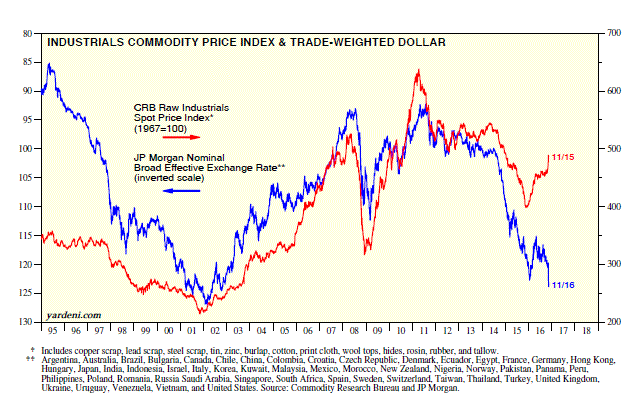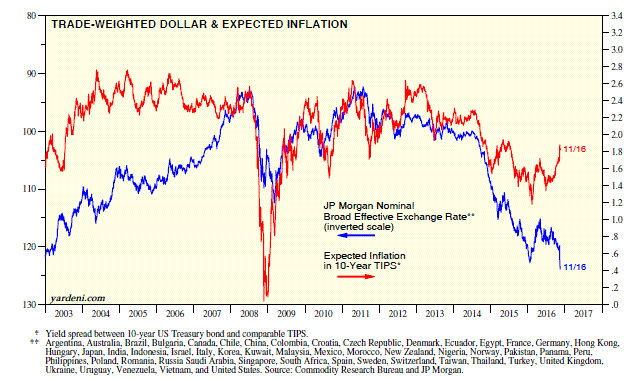
Trumponomics is a mix of demand- and supply-side economics. The former tends to be inflationary, while the latter tends to be disinflationary. That’s in theory. In practice, we will all find out together what the net result of mixing things up like this will do to inflation. On the demand side, President-elect Trump proposes to spend $1 trillion on infrastructure over the next 10 years. On the supply side, he proposes to slash the corporate tax rate. He also intends to reduce income tax rates on personal incomes, which can have both inflationary demand-side and disinflationary supply-side effects.
I think that on balance, the disinflationary supply-side effects will offset some, but not all, of the inflationary demand-side effects of Trumponomics. That certainly should greatly reduce the risk and fears of deflation. If so, then the 35-year bull market in bonds might have ended on July 8 of this year when the 10-year yield bottomed at a record low of 1.37%. It is already back up to 2.23%.
Much of that backup was attributable to the perception that no matter who won the presidency, there would be more fiscal stimulus. Now that Trump has won, that’s become a virtual certainty. After all, Trump's specialty is building things. Now let’s consider the various inflationary and disinflationary forces that are likely to be unleashed by Trumponomics, focusing on the data that will be especially important to monitor to assess how all these vectors will add up:
(1) Globalization vs. protectionism. Since the end of the Cold War, I have argued that globalization is inherently disinflationary. Now we are starting to see headlines such as “Goodbye, globalization.” It appeared at the top of a 11/13 Business Insider story that mentioned a cautionary note Bridgewater sent to clients on Friday, which warned, “The political backdrop looks negative for globalization.” Crispin Odey, another hedge fund manager, wrote in a recent note to clients, “Globalisation, competition, internationalism are now firmly in the retreat. Inflation and protectionism promise a future which is not as kind to financial assets as QE and deflation has been.”
Protectionism can be inflationary, as long as it doesn’t trigger a depression, which would be deflationary. The Smoot-Hawley Tariff of June 1930 caused a depression and a collapse in commodity and consumer prices. I recently have observed that the Reagan administration pursued policies that seemed protectionist at the time. Our major trading partners were pressed to adopt fairer trade practices in exchange for free trade with the US. The US economy continued to grow, and inflation remained subdued. I think that will be the outcome of the current protectionist wave. So I expect that Globalization will survive the latest challenges.
(2) Labor market. In a November 4 speech, Federal Reserve Vice Chairman Stanley Fischer said that in his view “the labor market is close to full employment.” He added that it wouldn’t take much by way of job gains to maintain the unemployment rate near 5%. That’s because he expects that the labor force participation rate will continue to decline due to the “likely drag from demographics.”
Specifically, he said that job gains of as low as 65,000 to 115,000 would be “sufficient to maintain full employment.” Even if participation rates were to remain unchanged, Fischer said a range of 125,000 to 175,000 job gains would prevent “unemployment from creeping up.” Nonfarm private payroll employment gains averaged 210,200 per month over the past five months through October.
The unemployment rate has been around 5% since last fall. Strong labor market indicators were also evident in the latest Job Openings and Labor Turnover Survey (JOLTS) and National Federation of Independent Business (NFIB) reports through September and October, respectively. According to both surveys, the rate of job openings exceeds levels during two of the past three cyclical peaks. Layoffs fell to the lowest on record, while quits were near a record high during September. Not surprisingly, quits are highly correlated with the Consumer Confidence index, which has been lagging but could jump higher now that the elections are over.
This all points to higher wage inflation. The Atlanta Fed’s median wage growth tracker shows that “job switchers” enjoyed a wage gain of 4.4% y/y during October versus 3.6% for “job stayers”. Average hourly earnings for all private industry workers rose 2.8% y/y during October, the highest since June 2009.
Trumponomics could put more upward pressure on wages given that most labor market indicators suggest that the economy is at full employment. There is already a shortage of construction workers that will be hard to fill, unless Trump allows special work visas for construction workers from Mexico. (See the 9/21 WSJ article titled “How an Immigration Downturn Has Contributed to the Construction-Worker Shortage.”)
(3) The dollar, oil, and other commodities. The soaring dollar and falling oil prices should help to moderate inflationary pressures in the labor market. The JPMorgan (NYSE:JPM) trade-weighted dollar is now up 24% from its low on July 1, 2014. That, along with OPEC’s inability to agree on production cuts, is depressing the price of oil. Trump’s commitment to “lift the restriction” on the US energy industry could very well drown the cartel in oil.
On the other hand, the CRB raw industrials spot price index is soaring. However, it is doing so as the dollar is doing the same, which is unprecedented. It is also extraordinary to see that inflationary expectations have jumped since the election, while the dollar has soared. In any event, the strong dollar is bound to put downward pressure on nonpetroleum import prices.
(4) Productivity. Over the past couple of years, there has been a widening consensus that secular stagnation is here to stay. I’ve been there too. Keynesian economists, like Larry Summers and Stanley Fischer, have argued that the only way out is more fiscal spending. Supply-siders have championed less government and tax cuts as the only sure way to revive growth. I’ve sided with the latter camp. Now Trump is proposing to do all of the above.
If he succeeds in boosting real economic growth, it might not be inflationary if it is based on productivity. I have argued that productivity has a demand side as well as a supply side. The productivity of the most efficient widgets factory in the world will be zero if demand for widgets is zero. Better economic growth could very well prove that the supply side of productivity can deliver more output, thus limiting inflation.

